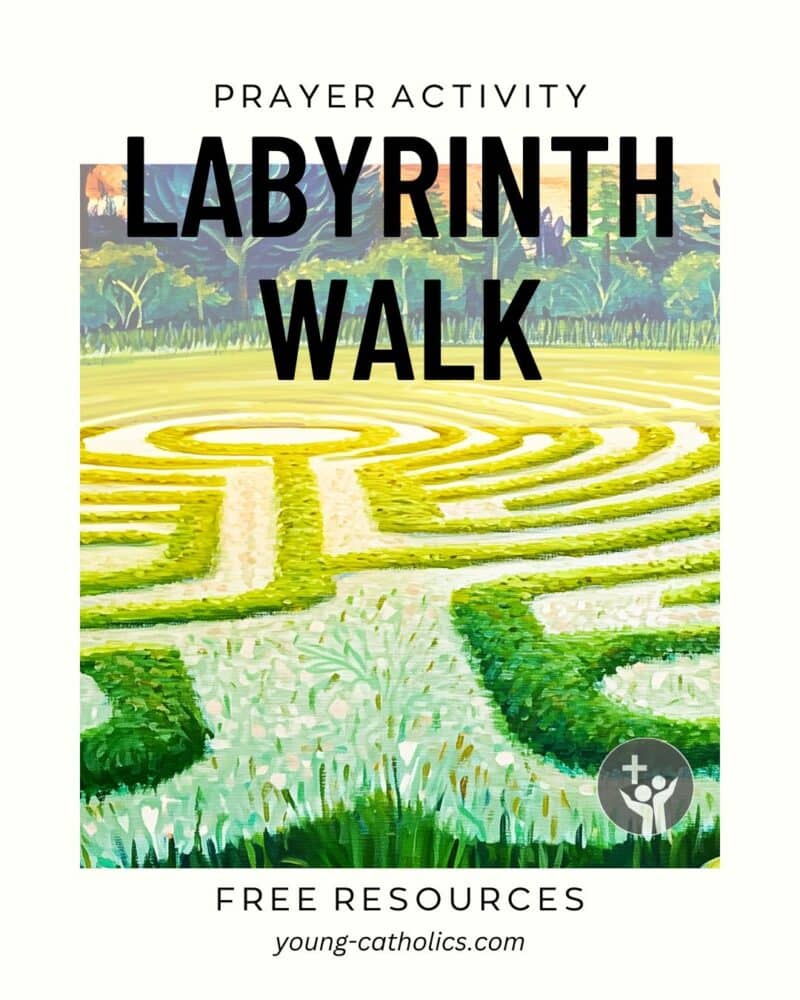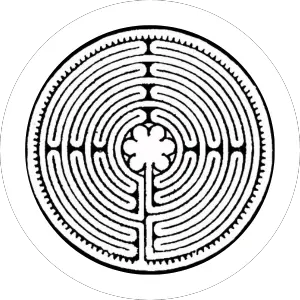Create Your Own Prayer Labyrinth

A prayer labyrinth is a simple but meaningful way to pray. It combines movement and prayer, helping people focus their minds and hearts on God. Walking the path of the labyrinth can bring peace and calm, making it easier to pray with intention. This practice has been part of Christian tradition since medieval times and is still used today as a way to grow closer to God.
The labyrinth is a symbol of our journey with God. Walking toward the center represents moving closer to Him in prayer. It is a time to let go of worries and listen for His voice. Reaching the center is a moment to pause and rest in His presence. Walking back out reminds us to carry what we have received in prayer into our daily lives.
Many people find the physical movement of the labyrinth helpful. It can be especially meaningful for those who pray better when moving rather than sitting still. It can also be calming for youth with Autism or ADHD, as the steady rhythm of walking can help focus their thoughts and quiet their hearts. The simple act of walking makes it an easy and welcoming way to pray for all ages.
A prayer labyrinth offers a quiet and thoughtful way to pray. It invites us to slow down, step away from distractions, and spend time with God. Each step is a reminder that prayer is a journey, and God walks with us as we seek His guidance and peace.
Walking a Sacred Path
The prayer labyrinth has been part of Christian tradition for hundreds of years. It became popular in the Middle Ages, especially in Europe. Many cathedrals built labyrinths into their floors as a way for people to pray. The most famous one is in Chartres Cathedral in France. Pilgrims who could not travel to holy sites would walk the labyrinth as a way to show their faith and devotion.
The design of the labyrinth is simple but meaningful. It has one winding path that leads to the center and then back out again. Unlike a maze, there are no dead ends or wrong turns. The path is clear and easy to follow, showing that prayer is about staying on the journey, not solving a puzzle. The walk to the center represents moving closer to God, and the walk back out represents bringing His peace and guidance into daily life.
Over time, prayer labyrinths have been used in many ways. Some are built inside churches or made with stone outdoors. Others are temporary, marked with chalk, rope, or tape. No matter the style, the purpose is the same: to create a quiet space for prayer and reflection. The simple pattern and steady steps help people slow down, focus, and listen to God.
A Journey of Faith and Prayer
The prayer labyrinth fits well with many themes in the Bible. Walking the path can remind us of the journeys we read about in Scripture. The Israelites wandered in the desert as they learned to trust God. Jesus often went to quiet places to pray. The walk to the center of the labyrinth can be a time to seek God, and the walk back out can remind us to live out our faith in the world.
This practice also connects with Catholic teaching about prayer. The Catechism says, “Prayer is the life of the new heart. It ought to animate us at every moment” (CCC 2697). The steady steps of the labyrinth help teach that prayer is part of our whole life, not just something we do at certain times. It shows that prayer can be active, using both body and mind to draw closer to God.
In youth ministry, the labyrinth can be a helpful tool. Many young people find it easier to pray when they are moving. The simple steps and clear path make it easy for them to focus. It can also help youth with Autism or ADHD by giving them a calm way to pray. Walking together as a group can lead to good discussions afterward about faith, prayer, and listening to God.
Using the labyrinth in catechesis can help young people understand that prayer is a journey. It is a way to teach them to listen for God’s voice and then act on what they have learned. Each step can be a reminder that we are called to follow Jesus, not just in quiet moments, but in all parts of our lives.
Setting Up Your Prayer Labyrinth
To create your own prayer labyrinth, you will need a few materials and follow some simple steps. Here is a list of materials you may consider using, along with step-by-step instructions to set up your prayer labyrinth.
Materials
- sidewalk chalk optional
- masking tape optional
- rope optional
- battery operated tea lights optional

Instructions
Lay out the labyrinth:
- If you are setting up the labyrinth indoors, find a large space such as a gymnasium. Mark the pattern of the labyrinth on the floor using masking tape. You can refer to the pattern shown.
- If you prefer an outdoor setting, find a parking lot or open area. Use sidewalk chalk to mark the pattern of the labyrinth on the ground. Again, you can follow the pattern shown in the instructions or create your own design.
- For a more natural setting, consider using long pieces of rope to outline the labyrinth on a field or grassy area. This can create a beautiful and immersive experience.
Enhance the ambiance (optional):
- If you plan to walk the labyrinth at night or want to create a more serene atmosphere, consider placing battery-operated tea lights along the path. These gentle lights can add a touch of tranquility and guide your way as you walk the labyrinth.
By following these simple instructions and using the materials that suit your preferences, you can set up your own prayer labyrinth. Whether indoors or outdoors, the labyrinth provides a sacred space for reflection, prayer, and connection with God. Take the time to create an environment that resonates with you and enhances your spiritual experience.
How to Pray with a Labyrinth
- Prepare Yourself
Begin by taking a few deep breaths. Ask God to guide you during this prayer. Let go of distractions and focus on being present with Him. - Start Walking
Step onto the path slowly. Walk at a calm and steady pace. There is no need to rush. Pray silently as you move. You can say simple prayers, repeat a Scripture verse, or just walk in quiet reflection. - Reach the Center
When you arrive at the center, pause. Spend time in quiet prayer or simply rest in God’s presence. You may offer prayers of thanks or ask Him to speak to your heart. Stay as long as you feel led. - Walk Back Out
When you are ready, begin walking out of the labyrinth. Think about how you will carry what you received in prayer into your daily life. Walk with gratitude and peace.
Additional Notes and Variations
- Walk alone or with others, but keep quiet to respect the prayer of others.
- If walking with a group, spread out to give each person space.
- Some people like to pray a rosary, say the Jesus Prayer, or reflect on a specific Scripture as they walk.
- For youth, you can give a theme, such as praying for family, friends, or the needs of others.
- If walking outside at night, make sure the path is well lit. Use battery-operated lights if needed.
- Remind participants to watch their step, especially on uneven ground or if the path is marked with ropes or chalk.
More Resources

More Catholic Prayers
If you are looking for more ways to pray, visit our Catholic Prayers page. It offers many different prayers and practices to help you grow closer to God. The prayer labyrinth is one of the prayers you will find there. It is a simple way to pray with movement and focus your mind on God.
The Catholic Prayers page also has traditional prayers, meditations, and other prayer ideas for all ages. Whether you want quiet personal prayer or something to use in a group, you will find helpful resources there. Take time to explore and discover new ways to deepen your prayer life.
Questions and Answers about the Prayer Labyrinth
What is a prayer labyrinth?
A prayer labyrinth is a simple path used for prayer and reflection. It has one winding path that leads to the center and then back out again. Unlike a maze, there are no tricks or dead ends. It is a tool to help people focus on God while walking.
Is the labyrinth Catholic?
Yes. The labyrinth has been part of Christian tradition for many centuries. Some famous cathedrals in Europe, like Chartres in France, have labyrinths built into their floors. Catholics use the labyrinth as a way to pray, reflect, and grow closer to God.
How do I use the labyrinth for prayer?
Walk slowly and quietly along the path. Pray as you go. Some people pray with words, while others walk in silence. The walk to the center is a time to let go of worries and listen for God. The walk back out is a time to think about how to live out what you have learned in prayer.
Can youth use the labyrinth?
Yes. The labyrinth works well for youth ministry. Many young people pray better when moving. The slow steps help them focus and calm their minds. It can also be helpful for youth with Autism or ADHD because the steady movement can make it easier to pray.
Do I need special materials to make a labyrinth?
No. You can make a simple labyrinth with chalk, rope, or tape. Some people use fields, gyms, or parking lots. What matters most is having a clear path to follow. The space should feel quiet and peaceful.
How long does it take to walk the labyrinth?
The time depends on the size of the labyrinth and how slowly you walk. Most walks take about 10 to 30 minutes. Take your time and do not rush. The goal is to pray and listen to God as you walk.
Walking with God in Prayer
The prayer labyrinth is a simple path for prayer and reflection. It has been used in Christian tradition for many centuries. The winding path leads to the center and then back out, showing our journey with God. It is not a maze, but a clear path that invites us to slow down and pray.
Walking the labyrinth is a way to let go of distractions. The steps help calm the mind and focus the heart on God. The walk to the center can be a time to listen for His voice. The walk back out is a reminder to take His peace and guidance into daily life.
The labyrinth can be used by anyone, but it is also helpful in youth ministry. Many young people find prayer easier when moving. It can be especially good for youth with Autism or ADHD, as the steady walking helps them focus.
This practice is a gentle way to spend time with God. It is a reminder that prayer is a journey, and God walks with us. The prayer labyrinth is a simple but meaningful way to pray with both body and mind.
Your Turn
Have you walked a prayer labyrinth before? We invite you to try it and see how it helps you connect with God. This simple prayer practice can bring peace and focus to your time with Him.
After you walk a labyrinth, share your experience in the comment section. Tell us how it helped you pray or how you might use it with others. Your thoughts can inspire others to try this prayer too.


Leave a Reply